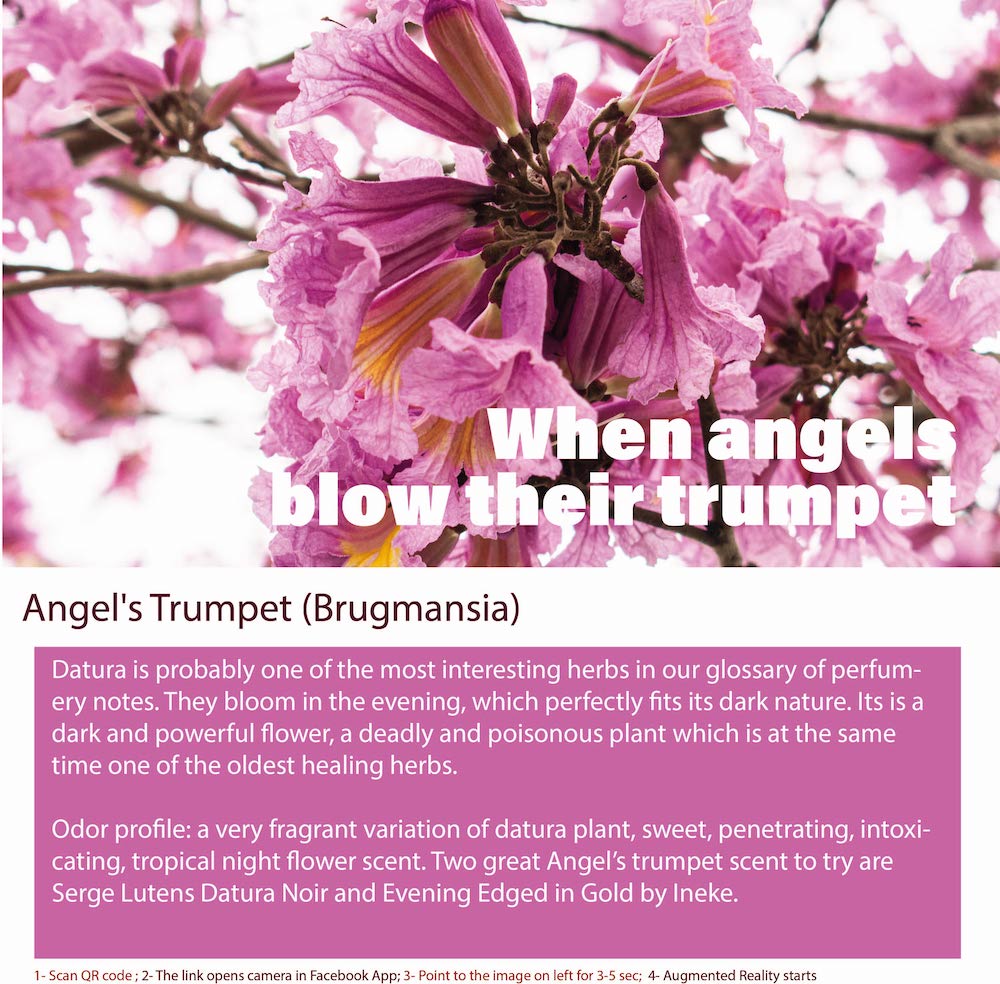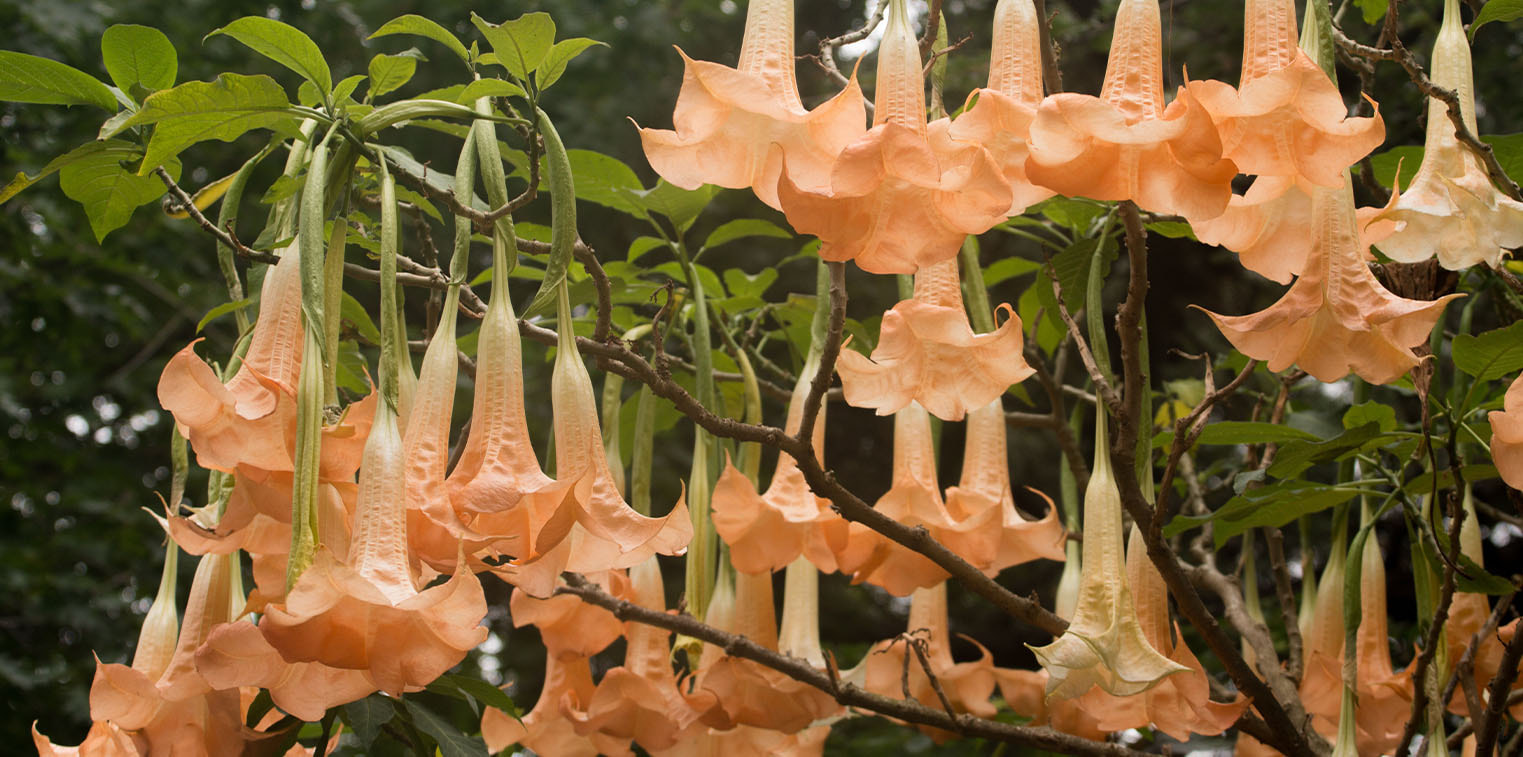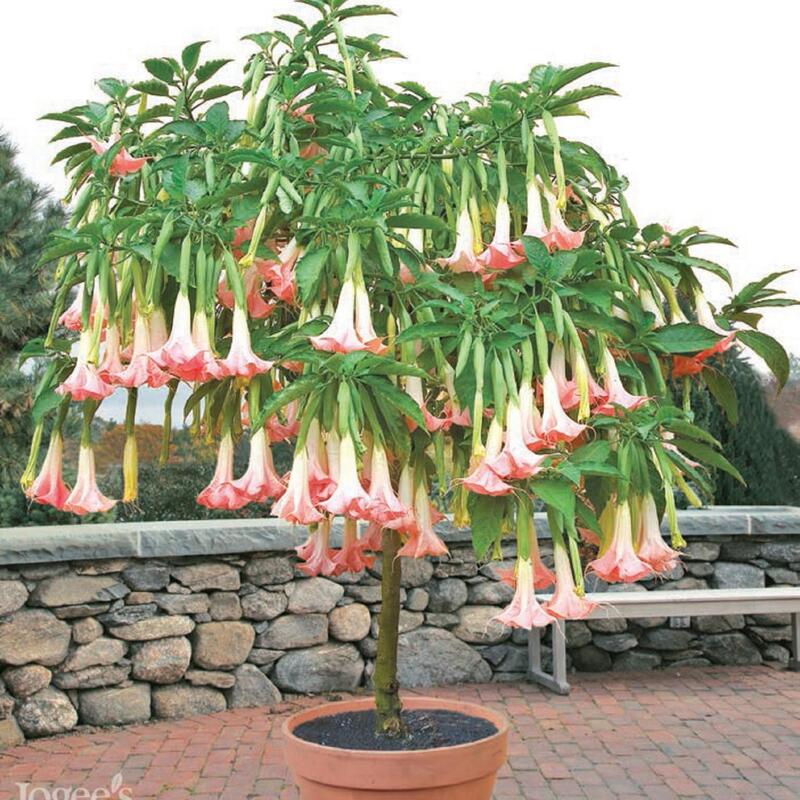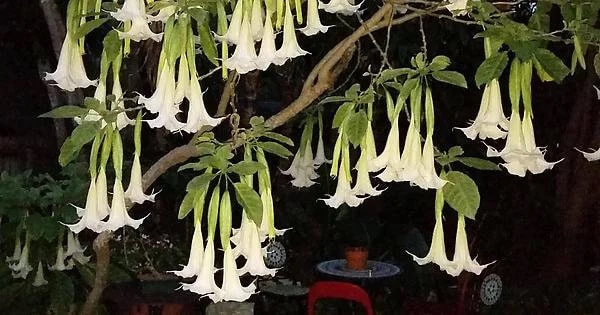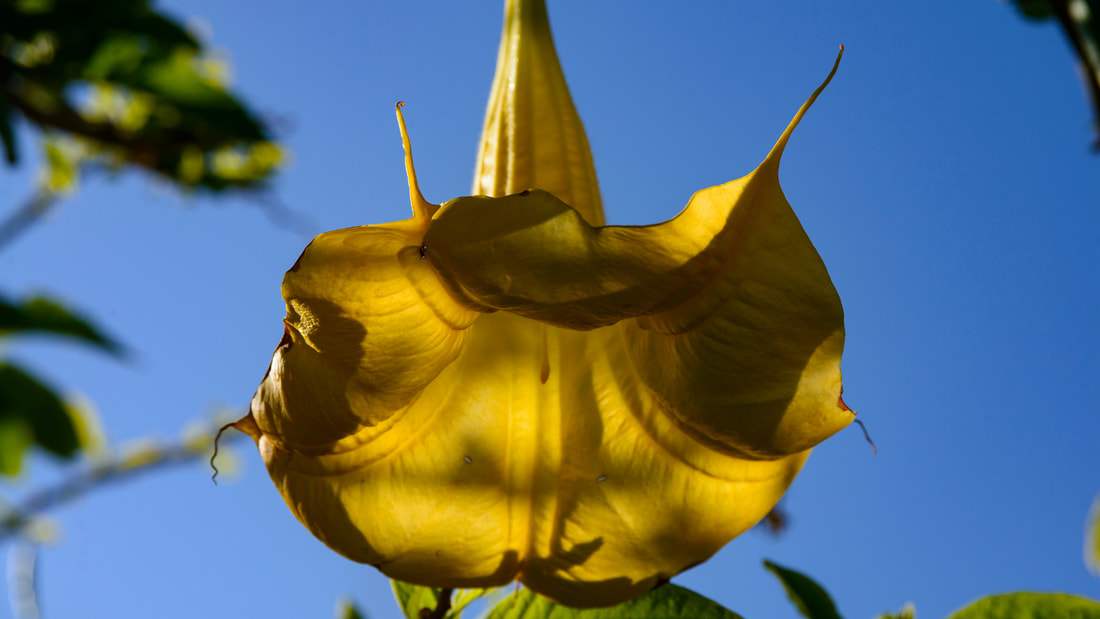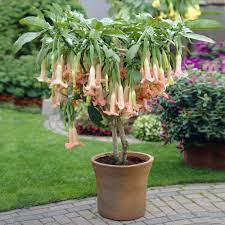Unveiling Our Angel's Trumpet Fragrance Collection
Angel's Trumpet: The Enchanting Flower of Legends and Aromas
Angel's Trumpet, also known as Brugmansia, is a striking and enchanting flower with a long history of captivating human imagination. From its alluring fragrance to its rich history in various cultures, this magnificent flower has found its way into perfumes, therapeutic oils, culinary delicacies, and even traditional medicinal systems. In this comprehensive article, we will delve into the world of Angel's Trumpet, exploring its mesmerizing fragrance, therapeutic benefits, culinary uses, medicinal properties, historical significance, and fun crazy facts that make it a truly unique and magical flower.
Botanical Characteristics:
Angel's Trumpet belongs to the genus Brugmansia, and there are several species known for their large, trumpet-shaped flowers that hang gracefully from the plant's branches. The flowers come in various colors, including white, pink, yellow, and peach, each exuding a distinct fragrance that varies from sweet and fruity to intoxicatingly floral.
Fragrance and Perfumes:
The fragrance of Angel's Trumpet is simply divine, often described as a heavenly blend of sweet floral notes with hints of jasmine, honeysuckle, and vanilla. Its beguiling aroma has made it a popular choice in perfumery, where it is used as a captivating middle note in various fragrances. The floral scent of Angel's Trumpet can evoke feelings of nostalgia, tranquility, and euphoria, making it a sought-after ingredient for creating unique and mesmerizing scents.
Therapeutic Oils and Aromatherapy:
The essential oil derived from Angel's Trumpet is used in aromatherapy for its soothing and calming properties. The fragrance of the oil is known to alleviate stress, anxiety, and depression, promoting relaxation and a sense of well-being. Inhaling the aroma of Angel's Trumpet essential oil is believed to create a harmonious and peaceful atmosphere, making it a popular choice for aromatherapy sessions and relaxation rituals.
Culinary Delights:
While Angel's Trumpet is not typically used in mainstream culinary practices due to its toxic nature, some cultures have incorporated it into traditional dishes in small quantities. In certain South American cuisines, the flower is used sparingly to add a unique and exotic flavor to certain recipes, carefully ensuring that its toxic compounds are neutralized through proper cooking methods.
Medicinal Properties:
In traditional medicinal systems of certain regions, Angel's Trumpet has been used cautiously for its potential medicinal properties. However, it is important to note that the plant contains toxic alkaloids that can be harmful if ingested in large amounts. In some cultures, it has been used topically for skin conditions and as a poultice for pain relief. However, it is crucial to exercise caution and seek professional advice before using Angel's Trumpet for any medicinal purposes.
Historical Significance and Legends:
Angel's Trumpet holds a special place in various cultures and legends. In certain South American and indigenous cultures, the flower is believed to have mystical properties and is associated with spiritual realms. Its trumpet-shaped blossoms have led to associations with celestial beings, angels, and divine messages, contributing to its name "Angel's Trumpet." In some cultures, the plant is considered sacred and used in religious ceremonies and rituals.
Fun Crazy Facts:
Angel's Trumpet, with its alluring fragrance, enchanting appearance, and diverse uses, has truly earned its place as a magical and captivating flower. From its role in perfumes and aromatherapy to its culinary and medicinal applications, this flower continues to mesmerize and inspire people across different cultures and regions. However, it is essential to approach Angel's Trumpet with caution and respect its toxic nature. Whether admired for its stunning blooms, cherished for its heavenly fragrance, or revered for its mystical qualities, Angel's Trumpet remains a symbol of beauty, wonder, and fascination in the vast garden of botanical wonders.
Angel's Trumpet, also known as Brugmansia, is a striking and enchanting flower with a long history of captivating human imagination. From its alluring fragrance to its rich history in various cultures, this magnificent flower has found its way into perfumes, therapeutic oils, culinary delicacies, and even traditional medicinal systems. In this comprehensive article, we will delve into the world of Angel's Trumpet, exploring its mesmerizing fragrance, therapeutic benefits, culinary uses, medicinal properties, historical significance, and fun crazy facts that make it a truly unique and magical flower.
Botanical Characteristics:
Angel's Trumpet belongs to the genus Brugmansia, and there are several species known for their large, trumpet-shaped flowers that hang gracefully from the plant's branches. The flowers come in various colors, including white, pink, yellow, and peach, each exuding a distinct fragrance that varies from sweet and fruity to intoxicatingly floral.
Fragrance and Perfumes:
The fragrance of Angel's Trumpet is simply divine, often described as a heavenly blend of sweet floral notes with hints of jasmine, honeysuckle, and vanilla. Its beguiling aroma has made it a popular choice in perfumery, where it is used as a captivating middle note in various fragrances. The floral scent of Angel's Trumpet can evoke feelings of nostalgia, tranquility, and euphoria, making it a sought-after ingredient for creating unique and mesmerizing scents.
Therapeutic Oils and Aromatherapy:
The essential oil derived from Angel's Trumpet is used in aromatherapy for its soothing and calming properties. The fragrance of the oil is known to alleviate stress, anxiety, and depression, promoting relaxation and a sense of well-being. Inhaling the aroma of Angel's Trumpet essential oil is believed to create a harmonious and peaceful atmosphere, making it a popular choice for aromatherapy sessions and relaxation rituals.
Culinary Delights:
While Angel's Trumpet is not typically used in mainstream culinary practices due to its toxic nature, some cultures have incorporated it into traditional dishes in small quantities. In certain South American cuisines, the flower is used sparingly to add a unique and exotic flavor to certain recipes, carefully ensuring that its toxic compounds are neutralized through proper cooking methods.
Medicinal Properties:
In traditional medicinal systems of certain regions, Angel's Trumpet has been used cautiously for its potential medicinal properties. However, it is important to note that the plant contains toxic alkaloids that can be harmful if ingested in large amounts. In some cultures, it has been used topically for skin conditions and as a poultice for pain relief. However, it is crucial to exercise caution and seek professional advice before using Angel's Trumpet for any medicinal purposes.
Historical Significance and Legends:
Angel's Trumpet holds a special place in various cultures and legends. In certain South American and indigenous cultures, the flower is believed to have mystical properties and is associated with spiritual realms. Its trumpet-shaped blossoms have led to associations with celestial beings, angels, and divine messages, contributing to its name "Angel's Trumpet." In some cultures, the plant is considered sacred and used in religious ceremonies and rituals.
Fun Crazy Facts:
- Hallucinogenic Qualities: Some species of Angel's Trumpet contain toxic alkaloids like scopolamine and atropine, which can cause hallucinations and delirium when ingested in large quantities. However, these qualities also make the flower dangerous if not used responsibly.
- Moonflower's Nighttime Cousin: Angel's Trumpet is often compared to the Moonflower (Ipomoea alba), another enchanting night-blooming flower with a captivating fragrance. Both flowers are known for their intoxicating scents that fill the night air.
Angel's Trumpet, with its alluring fragrance, enchanting appearance, and diverse uses, has truly earned its place as a magical and captivating flower. From its role in perfumes and aromatherapy to its culinary and medicinal applications, this flower continues to mesmerize and inspire people across different cultures and regions. However, it is essential to approach Angel's Trumpet with caution and respect its toxic nature. Whether admired for its stunning blooms, cherished for its heavenly fragrance, or revered for its mystical qualities, Angel's Trumpet remains a symbol of beauty, wonder, and fascination in the vast garden of botanical wonders.
To experience augmented reality, please open the Facebook-app using QR code and point to the image below
Elevate Your Space with Exquisite Floral Aroma
Angel's trumpet (Brugmansia) is a tropical flowering plant native to South America. It is a member of the nightshade family and is related to tomatoes and potatoes.
The plant is known for its large, fragrant flowers that can be white, yellow, pink, or orange. The flowers are trumpet-shaped and hang down from the plant, hence the plant's common name. Angel's trumpet is often grown as an ornamental plant in gardens and is also used in traditional medicine in some parts of the world. However, the plant can be poisonous if ingested, so it is important to keep it out of reach of children and pets.
The plant is known for its large, fragrant flowers that can be white, yellow, pink, or orange. The flowers are trumpet-shaped and hang down from the plant, hence the plant's common name. Angel's trumpet is often grown as an ornamental plant in gardens and is also used in traditional medicine in some parts of the world. However, the plant can be poisonous if ingested, so it is important to keep it out of reach of children and pets.
Captivating Aroma of Fresh Angel's Trumpet Blooms
The scent of the flowers is often described as sweet and pleasant, and the plant is often grown for its decorative and aromatic properties.
The flowers are most fragrant in the evening and at night, which is why the plant is sometimes called the "scented trumpet" or the "fragrant trumpet." Some people find the scent of angel's trumpet to be overpowering or unpleasant, so it is not a plant for everyone. The scent of the flowers can be used to make perfumes and other fragrant products, and the plant is sometimes used in traditional medicine for its aromatic properties.
The flowers are most fragrant in the evening and at night, which is why the plant is sometimes called the "scented trumpet" or the "fragrant trumpet." Some people find the scent of angel's trumpet to be overpowering or unpleasant, so it is not a plant for everyone. The scent of the flowers can be used to make perfumes and other fragrant products, and the plant is sometimes used in traditional medicine for its aromatic properties.
Bringing Nature's Beauty into Your Home
Angel's trumpet is fast-growing that can reach heights of up to 15 feet (4.5 meters) when grown in the right conditions. It prefers warm, humid environments and needs plenty of sunlight to thrive. The plant can be grown in a variety of soils, but it prefers well-draining soil that is rich in organic matter.
To plant angel's trumpet, choose a sunny location in your garden and prepare the soil by adding compost or other organic matter. Plant the angel's trumpet seedlings or seeds in the ground at the same depth as they were in the pot or seed tray. Water the plants regularly to keep the soil evenly moist, but be careful not to overwater, as the plant does not tolerate standing water. Fertilize the plant regularly with a balanced fertilizer to promote healthy growth.
Angel's trumpet can be prone to pests and diseases, so it is important to keep an eye out for any problems and take appropriate action if necessary. Common pests that affect angel's trumpet include aphids, whiteflies, and spider mites. Diseases that can affect the plant include root rot, leaf spot, and powdery mildew. To prevent these problems, provide the plant with good growing conditions, such as adequate sunlight, water, and nutrients, and practice good garden hygiene by removing any dead or damaged plant material.
To plant angel's trumpet, choose a sunny location in your garden and prepare the soil by adding compost or other organic matter. Plant the angel's trumpet seedlings or seeds in the ground at the same depth as they were in the pot or seed tray. Water the plants regularly to keep the soil evenly moist, but be careful not to overwater, as the plant does not tolerate standing water. Fertilize the plant regularly with a balanced fertilizer to promote healthy growth.
Angel's trumpet can be prone to pests and diseases, so it is important to keep an eye out for any problems and take appropriate action if necessary. Common pests that affect angel's trumpet include aphids, whiteflies, and spider mites. Diseases that can affect the plant include root rot, leaf spot, and powdery mildew. To prevent these problems, provide the plant with good growing conditions, such as adequate sunlight, water, and nutrients, and practice good garden hygiene by removing any dead or damaged plant material.
Exploring the Scentopia Singapore Difference
The flowers can be white, yellow, pink, or orange, and some varieties have flowers that are bi-colored or have patterns on them. The color of the flowers depends on the variety of the plant and can vary widely. Some common varieties of angel's trumpet and their flower colors include:
- Brugmansia suaveolens (white): This variety has large, white flowers that are very fragrant.
- Brugmansia sanguinea (red or orange): This variety has red or orange flowers that are less fragrant than other types of angel's trumpet.
- Brugmansia arborea (yellow): This variety has yellow flowers that are very fragrant.
- Brugmansia versicolor (pink or white): This variety has pink or white flowers that are very fragrant.
Experience Aromatherapy like Never Before
There are several myths and legends surrounding angel's trumpet (Brugmansia), a tropical flowering plant native to South America. One common myth is that the plant is poisonous and can cause hallucinations or even death if ingested. While it is true that the plant contains toxic compounds that can be harmful if ingested, the plant is not necessarily deadly. Symptoms of angel's trumpet poisoning may include nausea, vomiting, hallucinations, and confusion. In severe cases, the plant can cause coma or death. However, it is important to note that the plant's toxicity varies depending on the individual and the amount of the plant that is ingested.
Another myth surrounding angel's trumpet is that the plant has magical or supernatural properties. Some people believe that the plant can be used to communicate with spirits or that it can be used to predict the future. There is no scientific evidence to support these claims, and it is generally believed that these beliefs are the result of cultural or traditional practices.
Despite these myths, angel's trumpet is a popular ornamental plant that is grown for its decorative and aromatic qualities. The plant is known for its large, fragrant flowers that can be white, yellow, pink, or orange, and it is often grown in gardens or used in traditional medicine in some parts of the world. However, it is important to handle the plant with caution, as it can be poisonous if ingested.
Another myth surrounding angel's trumpet is that the plant has magical or supernatural properties. Some people believe that the plant can be used to communicate with spirits or that it can be used to predict the future. There is no scientific evidence to support these claims, and it is generally believed that these beliefs are the result of cultural or traditional practices.
Despite these myths, angel's trumpet is a popular ornamental plant that is grown for its decorative and aromatic qualities. The plant is known for its large, fragrant flowers that can be white, yellow, pink, or orange, and it is often grown in gardens or used in traditional medicine in some parts of the world. However, it is important to handle the plant with caution, as it can be poisonous if ingested.
Crafted with Care for Authentic Floral Fragrance
The plant has a long history of use in traditional medicine and cultural practices in its native range. In some parts of South America, the plant is used to treat a variety of ailments, including asthma, colds, and fever. The plant's leaves and flowers are also used to make tea, which is believed to have sedative properties.
Join Scentopia, Sentosa's latest tourist attraction wonderful orchid scent crafting, fragrance tour, bridal shower or corporate team building which includes perfume making onsite and offsite, beach activities and more. We also serve primary school learning journey, secondary students and pupil on industrial excursions. Know more about our orchids perfume bar or therapeutic orchid scents and other wellness aromas. Conatct Perfume workshop or book a scent crafting session here.

